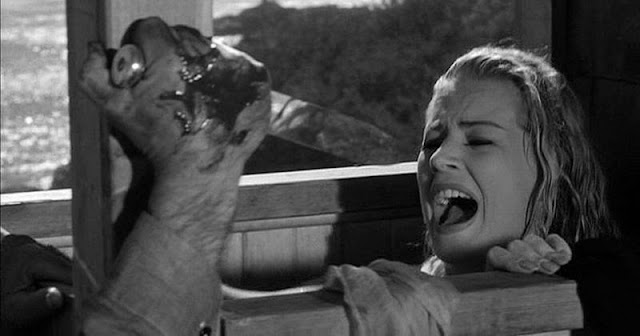Recently watched: Paid in Full (1950). Tagline: “The story of a woman’s bitter victory.” I’m using this period of enforced social isolation to explore the weirder corners of YouTube for long forgotten and obscure movies. (My boyfriend is accompanying me only semi-willingly).
Paid in Full opens on a note of panicked urgency, instantly plunging the viewer into the action. A pregnant woman in agonizing labour and on the verge of collapse manages to drive herself to the hospital on a stormy night. We learn that she’s Jane Langley (portrayed by magnetic film noir queen Lizabeth Scott). Due to life-threatening medical complications, Jane must undergo an emergency cesarean, but the dilemma is stark: either mother or baby will survive – but not both! Jane is asked for the father’s identity so the hospital can contact him, which prompts a flashback to explain just how we got to this crisis point.
The luminous Scott alternated between bad girl (Dead Reckoning (1947), Too Late for Tears (1949)) and good girl (The Strange Love of Martha Ivers (1946), Desert Fury (1947), Pitfall (1948)) roles with equal conviction. But calling the supremely virtuous, long-suffering Jane Langley “good” barely beings to cover it! Jane, you see, is hiding a painful secret (actually, multiple painful secrets – but that doesn’t become apparent until later). Her mother died tragically after giving birth to Jane’s little sister Nancy (foreshadowing alert!). Dutifully stepping into the maternal role, Jane raised Nancy herself. As adults, Jane is a clothing designer and Nancy (Diana Lynn) is a model who sashays around a department store showroom flourishing her sister’s creations. Jane is secretly, unrequitedly in love with Nancy’s fiancé, dashing advertising executive Bill Prentice (blandly handsome Robert Cummings. He’s like a walking ad for Brylcreem). In fact, Bill is so oblivious he rehearses his marriage proposal spiel on Jane! Stoically swallowing her heartbreak, Jane wishes the couple well. Did I mention that toxic Nancy is a spoiled rotten, selfish little bee-yatch? (Kudos to Lynn, who imbues Nancy with an almost Gloria Grahame-like surly petulance. Jane’s unwavering devotion to the undeserving Nancy has echoes of the Joan Crawford / Ann Blythe dynamic in Mildred Pearce (1945)).
Paid in Full positions Nancy as the glamorous, sexually irresistible-to-men sister, whereas unlucky-in-love, married-to-her-career, always-the-bridesmaid singleton Jane is meant to be comparatively plain. But this is relative! Paid in Full is, after all, a golden age Hollywood production, and Jane is portrayed by the impossibly sultry Scott (Oh! That raspy voice!), who is exquisitely costumed (by Edith Head) and coiffed throughout. (In fact, the willowy Scott better resembles a fashion model than Lynn. Like her contemporary Lauren Bacall, Scott’s entryway into films was via modelling). The ever-sardonic Eve Arden offers comic relief as Tommy Thompson, Jane’s wise-cracking gal pal and work colleague. But Tommy also serves as a warning to Jane. As Bill cautions, Tommy “waited too long to get married. Now she’s too eager.”
/ This smiling threesome is wildly unrepresentative of Paid in Full /
Mid-century melodramas routinely romanticized the notion of a woman’s noble self-sacrifice. Paid in Full stretches this to the point of lunacy. The film begins as an absorbing if conventional romantic triangle. After a shocking and hideous tragedy occurs towards the end, the tone of Paid in Full goes full-tilt nuts, with Jane tipping into complete martyrdom and masochism. (The full significance of the title gradually becomes horribly apparent!). As a social document of its era, Paid in Full offers some fascinatingly archaic attitudes towards conceptions of matrimony, motherhood, fertility and “spinsterhood.” Watch the film here:














































